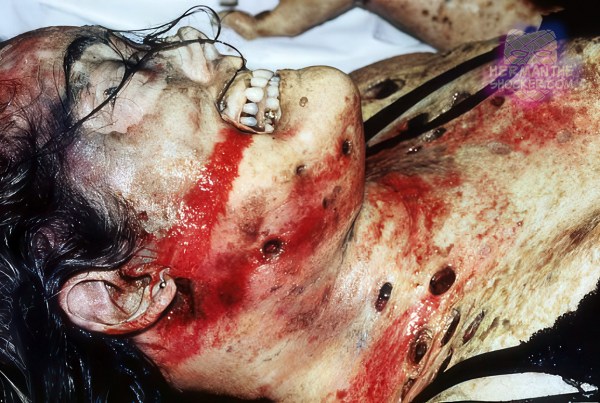Germany. In a case of extended suicide, a man killed his wife with a contact gunshot to the back of the head from a single-barreled 12-gauge “Baikal” shotgun loaded with a Brenneke shotgun slug. The woman was lying in the bed and her shattered head rested on blood-soaked pillows similar to a sleeping position. Multiple small blood spatter stains, brain particles, and bone fragments were present in the room up to a distance of 5 m. The stains on the rear wall were concentrated in a radial pattern (approx. 160°) which also showed a funnel-shaped soot stain and an oval missile defect.
The position of the stains indicated that the woman’s head was slightly raised at the moment of the gunshot. A large and deformed lead projectile was found behind the rear wall in a hollow space. The head of the woman showed a star-shaped laceration of the scalp running from the back of the head over the vault to the face. The right eye was destroyed and the cerebrum was completely missing. The cerebellum and the brain stem were severed in the region of the pons and a thin film of subarachnoidal bleeding surrounded the cerebellum. The trajectory most likely passed from the back of the head through the right side of the brain to the forehead close to the base of the skull. Signs of acute anaemia and a fatty liver but no additional pre-existing diseases could be found during autopsy.
The man then shot himself in the forehead while lying on his back in the bed. The frontal bone fragments were covered with soot. A portion of the scalp with attached hair, skull fragments, and brain tissue was found in the vicinity. The scalp of the man showed a star-shaped jagged laceration running from the nose over the forehead and the vault to the back of the neck with several tears radiating to both sides. Isolated ruptures of the skin due to distension were located at the forehead and the medial aspects of both eyes. The bones of the vault and the base of the skull were completely shattered and the cerebrum was missing. The cerebellum, which was surrounded by a thin film of subarachnoidal bleeding, and the brain stem were still in situ but showed lacerations and hemorrhages in the upper portions. Signs of acute anemia and a fatty liver were present.
The pillow and the mattress showed a missile defect underneath the head. A deformed lead projectile with wadding material attached to the base by a metal screw and feathers and textiles adhering to it was found in a wooden cross-rib of the bed. Next to the bed lay the 12-gauge shotgun which the man had bought the day before the incident. The closed chamber contained a spent cartridge case (70 mm “Rottweil Brenneke”) and an identical cartridge case lay on the floor. The blood alcohol concentration was zero in both cases. The shattered skulls, the ejected or pulpified brains, and the large and irregular lacerations of the scalps extending over the nose indicate very high intracranial overpressure in both cases. The isolated skin ruptures in the face and forehead of the man in the vicinity of the entrance wound may be due to a strong subcutaneous effect of the muzzle gases.
Latest posts











